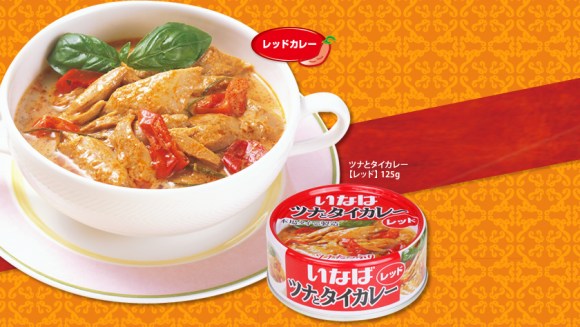
Consider the following scenario: you’re having a chat with a friend about some of the high quality foods on the market out there. You mention some of the more refined dishes you’ve tried first hand and how, as much as you’d like to eat them day after day, doing so would undoubtedly leave a large hole in your wallet. If your friend responded by saying, “I have a product just for you. It’s got the high class factor, is easy on the finances, and is packed into a small can.”, I’m sure you’d think he’d lost the plot a little.
Inaba and other Japanese food companies beg to differ, and have developed a new set of canned food products that turn the notion that cheap ≠ quality on its head.
The Inaba series includes such items as “tuna & Thai curry” and “chicken & Thai curry”. Whilst remaining loyal to the 100 yen, or $1, price range, these deceptive little tins will make you feel like you’re eating a gourmet meal.
This series of low price-high class taste in a can has even been getting attention on the internet in Japan. “The existing image of canned food may be one of blandness and poor quality, but in recent years the quality has reached quite a remarkable level. Needless to say that the price is as cheap as ever”, explains Yuto Kurokawa, an experienced collector of canned foods from around the world.
Yahoo! Japan did a bit of research into the type of ‘100yen’ canned foods out there . Be warned, the items introduced below just might leave your mouth in a fit of taste bud titillation.
First up is Inaba from above. Whether it be their “Thai Curry”or “Tomyam Chicken”, the pure level of skill that has gone into recreating a delicate flavour on par with a more expensive product is quite something. The “Tomyam Chicken“ in particular has that authentic Thai taste with a tingling spiciness that will leave you rubbing your eyes in disbelief that this came out of a can.
If this wasn’t enough, there’s even a “Chicken Soboro with Basil” (soboro is like minced chicken), seasoned with just the perfect level of garlic. According to Kurokawa, this is arguably in league with taberu rayu (Japanese chili paste) in terms of being a perfect accompaniment to rice.
“At any rate, the actual amount of retailers handling “Chicken Soboro” and “Tomyam Chicken” are on the small side to say the least. If you find yourself having a rare-chance encounter with either of these products, it would surely be best to smack down your 100 yen right away so as to save any disappointment afterwards”, admits Kurokawa.
In addition, Inaba also offers more standard canned foods like mixed beans and tuna. Both of these when mixed and cooked with rice make splendid dishes.
It’s not just Inaba that’s reforming the idea of price and quality. Like-minded competitors are also hot on the heels. Japanese company Kyokuyo recently redefined the idea of canned mackerel pike with their “Mackerel Pike with Grated Japanese Radish”. Up until now, the grated radish tended to melt or dissolve into the surrounding ingredients during manufacturing. However, thanks to the development of a unique manufacturing process, all is preserved as it should be in an ecstasy of freshness.
Want a few more recommendations for top-notch Japanese canned food? New Years is to Japan what Thanksgiving is to America in terms of food, and during this period a variety of delicious food called osechi makes its debut. Here a company called Maruhanichiro has taken one of the foods from osechi, herring or makeral pike wrapped in Japanese kelp and seaweed, and reinvented it into can form.
Carrying particular favour as a household range of products is Lawson’s boiled Japanese radish range (below). It has a distinct refined taste far detached from his 100yen price range.
Next a product receiving great review for its soft, tender ingredients is Horikafoods’ meat sukiyaki range.
Lastly , is Portugal’s “Mussels in tomato sauce” which is on sale at a selection of import product specialist shops. Whatever the brand, these 100 yen can foods create a high class menu that is clearly in disagreement with the price tag.
In some ways it is difficult to shake off the image that canned food equals emergency rations but if current trends are anything to go by this could all be set to change! Most of the above tinned foods are admittedly for the Japanese market but what do the readers out there, who aren’t living in Japan, think about the quality of the tinned food in your own country? How does it compare? Let’s us know in the comments section!
Link: r25.yahoo.co.jp
Headset image: inaba-foods.jp
Inset image: inaba-foods-online.com, kyokuyo.co.jp, food.maruha-nichiro.co.jp, umamikyo.gr.jp, beeboo.co.jp, http://mognavi.jp, http://kobeokamoto.jp